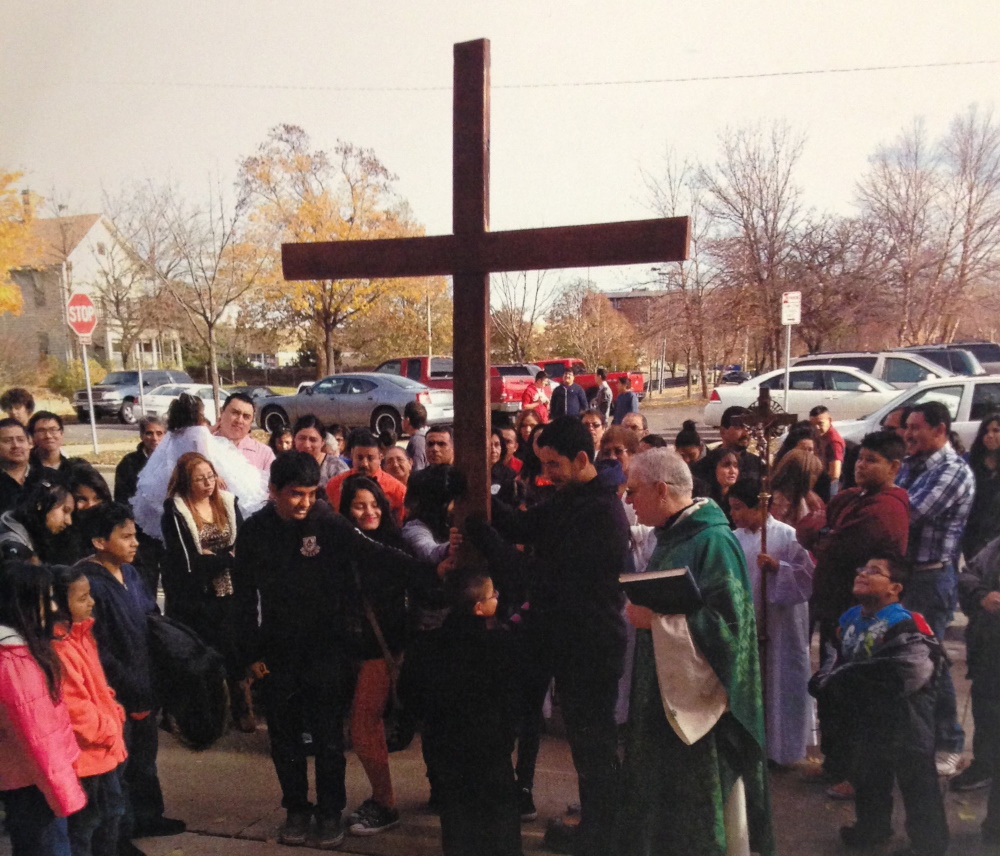“How can we grow in our capacity to live in full the liturgical action?” asks Pope Francis in his June 29 apostolic letter on liturgical formation. “How do we continue to let ourselves be amazed at what happens in the celebration under our very eyes?” (31).
I think this may be the most important question before us as catechumenate ministers. In a previous post, we looked at how seekers—or any of us—come to know who God is. The fullest, clearest, most intimate, most human way is in the celebration of the liturgy. But if we fail “to be astonished at the beauty of the liturgy” (65), we will fail to fully encounter Christ.
So how do we open our eyes and hearts—and the eyes and hearts of our seekers—to the beauty of the liturgy?
Quoting German theologian Romano Guardini, Pope Francis tells us the first thing we have to do is become “capable of symbols” (44). Guardini believed, and Pope Francis agrees, that we have lost our capacity to think and speak symbolically.
What does it mean to be “Capable of Symbols”?
Today, symbol is generally misunderstood to be something fake and second rate. This illiteracy in symbolic language was highlighted in a Pew study on Catholic belief that found 69% of Catholics believe the consecrated bread and wine “are symbols of the body and blood of Jesus Christ” while 31% believe that the bread and wine “actually become the body and blood of Jesus.”
Someone capable of symbols would know immediately that both these statements are true at the same time. A symbol is not a false representation of some more-true reality. A symbol participates in the reality it symbolizes. Think of your wedding ring. The moment your beloved put that ring on your finger, it was forever transformed from an ordinary ring to a ring that both symbolizes and is truly part of your love. If you lost it, another ring, even if identical in composition and style, would never be your wedding ring.
So what is the solution? How do we form ourselves to become “capable of symbols”? We can start by identifying some liturgical symbols. The pope lists many of them in his letter: “bread, wine, oil, water, fragrances, fire, ashes, rock, fabrics, colors, body, words, sounds, silences, gestures, space, movement, action, order, time, light” (42).
But symbols are not static objects. For symbols to be sacramental, we have to use them. So the full symbolism of the bread and wine is evident when we take, bless, break or pour, and share the bread and wine. Oil reaches its full symbolic meaning when we bless and anoint. Water becomes baptismal when we plunge someone into it in the name of the three Persons of the Trinity.
Next, we can increase our capacity for becoming “capable of symbols” by employing the ancient practice of mystagogical reflection. This is the method used in the Emmaus story in which Jesus patiently helped the clueless disciples get a clue. It is the method Pope Benedict XVI recommends in his 2007 exhortation on the eucharist in order to “lead the faithful to understand more deeply the mysteries being celebrated” (Sacramentum caritatis, 64).
Pope Benedict describes three movements: a look back, a look at the present, a look forward. Using water as an example, here is how each movement deepens our capacity for being amazed by the symbol of water.
A look back
Next time you are bathing, remember the last baptism you participated in. As you wash, recall some of the many ways God used water to save God’s people. Pope Francis lists several, and you can probably think of others (see On the Liturgical Formation of the People of God, 13):
- Regenerated humanity through the flood (Gn 6:1-9,29)
- Separated the water of the Red Sea to open the way of freedom (Ex 14)
- Consecrated the water of the Jordan, “plunging into it the flesh of the Word soaked in the Spirit” (Mt 3:13-17; Mk1:9-11; Lk 3:21-22)
- Blended water with the blood of the Son, “and from his pierced side he poured it out over us” (Jn 19:34)
A look at the present
As you wash, think of all the ways in which God continues to use water to save and bless you today. Here are examples, but think of your own experience.
- I have fresh, clean water every day for drinking and cooking
- I have plenty of water to clean the dust and grime from my body
- I live near the ocean and regularly stand at the seashore letting God fill my heart with the wonder of creation
- Through the community’s frequent celebration of baptism, I am reminded of the water that incorporated me into the Body of Christ and gave me everlasting life
The process of mystagogical reflection is simple enough that children can do it. But it takes constant discipline to do this regularly enough that we become fluent in symbolic language.
A look forward
Think of what all this means for you as a Christian. What is the “so what?” Use these examples to spur your own thoughts.
- Massive flooding and devastating drought plague the world. How am I called to respond?
- More than a billion people do not have access to clean water. What organizations need my financial and volunteer support?
- Who in my neighborhood is so beaten down that they cannot see the wonder and amazement of God’s creation? How can I ease their burden?
- Who do I need to invite into friendship with Jesus so that they too may be plunged into the waters of baptism to live with him forever?
You can do this mystagogical process as a personal reflection. You can do it as a household discussion. You can do it as a small group faith formation process with your seekers. You can also apply this to any of the other symbols we use in the liturgy.
The process of mystagogical reflection is simple enough that children can do it. But it takes constant discipline to do this regularly enough that we become fluent in symbolic language.
Here is one suggestion for beginning a spiritual discipline. Choose one day of the week to reflect on the Sunday liturgy. For example, every Monday at 7 a.m., block out ten minutes. Begin by mentally walking through the liturgy from the day before. Pay attention to what struck you, what intrigued you, what filled you. Land on one thing: a gesture, a phrase, an object, an action.
Hold that one thing in your heart. Then recall examples of how God has used that one thing to reveal God’s love in the past. Think about how that one thing is active in your life as a Christian today and the blessings God bestows on you. And ask yourself, so what? If God has blessed the world in the past and is blessing you today through the thing you are remembering, how will you go forward to extend that blessing in the world?
If you spend that ten minutes a week, every week, throughout the liturgical year reflecting on the mystery of God’s love that we celebrate in the liturgy, you will very soon become “capable of symbols” and become capable of celebrating the liturgy in a fully conscious and active way. You will be, as Pope Francis says, “amazed at what happens in the celebration under our very eyes” (31).
Your Turn
What role do symbols and symbolic language play in your parish catechumenate process? How do they resonate with your seekers and catechumens? Share your thoughts in the comments below.
Coming This June: A Journey of Accompaniment and Mission!
Team Initiation Members—don’t miss our upcoming exclusive four-part online speaker series:
Embodying the Heart of Synodality through the Catechumenate
Join us as we explore what it means to walk with seekers and parishioners in a spirit of accompaniment.
📅 Mark your calendars:
Four Wednesdays in June 2025
11:00am Pacific / 2:00pm Eastern
(June 4, 11, 18, and 25)
👉 This series is available only to Team Initiation Members.
Not a member yet? Click here to join today.












A wonderful essay in every respect, Nick–thank you!
I always feel discouraged when I hear Catholics insist that “the eucharist is not a symbol,” because it shows that we have lost exactly the sense of symbols that you describe. If the eucharist is not a symbol, it loses all connection to the rich natural meaning of bread, wine, food and drink. It loses all connection to the history of Israel–manna and Passover and all. It even loses connection with the story of Jesus himself and his sharing of meals.
Many years ago, I read a passage by theologian Gustave Martelet on the meaning of “symbol.” The Greek roots mean “throw together.” In the ancient world, a “symbolon” could be an object–a piece of bone or pottery, say–that two people who made a business deal would break. Later, a representative of one of them could be recognized by fitting together the “symbolon.” So a symbol functions to bring together what should be together, to unite.
As I thought about this later, it occurred to me that another Greek word had a nearly opposite meaning. It was something “thrown across” that separates what should be united: dia-bolos, the devil. Whatever conception we may have of the diabolical, it seeks to separate what God would unite. Perhaps one way it does so is by dulling our sense of symbols!
Thanks also for the simple mystagogical practice that you recommend–an excellent way for us to become more “capable of symbols.”
Hi Andrew. I’m glad you liked the article. Thanks for sharing your thoughts. I really like your insights about the Greek roots of symbol and diabolical.
Nick